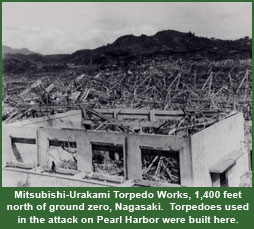
Places
"Met Lab"
(Metallurgical
Laboratory)
CITY OF NAGASAKI Places > Other Places
Places > Other Places
The city of Nagasaki is located in southwestern Japan, on the island of Kyushu. The city became an important port after Portuguese traders and missionaries landed nearby in 1542. For the next century it was the center of Catholicism in Japan, until the Tokugawa rulers suppressed the religion after associating it with disloyalty. However, Nagasaki remained one of the few open ports for foreign traders when the Tokugawa closed Japan to outside trade. The city was renowned throughout Japan for its cosmopolitanism in these years. Nagasaki's history as a meeting place for European and Japanese cultures has been immortalized in Puccini's opera Madame Butterfly. The city of Nagasaki capitalized upon its mercantile history during the Meiji Restoration in the late 19th century by becoming one of the country's major centers of ship-building. Many of the warships used by the Japanese Navy, including many of the ships used in the attack on Pearl Harbor, came from the city's shipyards. The combination of Nagasaki's heavy industry and its cultural significance made it an attractive target for American military planners. 
On August 9, 1945, the plane Bock's Car set off from Tinian Island with Fat Man, a plutonium-core implosion weapon, similar to the bomb that had been tested at Trinity. Its primary target was the city of Kokura, though poor visibility deterred the pilot from attacking. The plane returned to Tinian by way of his secondary target, Nagasaki, eighty miles to the southwest. As he circled the city, the clouds broke and he dropped the bomb, making it the second city to be destroyed by an atomic bomb. You can read more about the events of August 9, 1945 here. Henry Stimson hoped that this second atomic bomb would convince the Emperor of Japan to surrender, though a third bomb was ready to be brought to Tinian should this one not suffice. The city of Nagasaki was fully rebuilt after the war. It continues to be one of the country's major ports, and the home to the largest Catholic population in Japan. Nagasaki had occupied a peculiar place in Japan for being the place where the influence of the outside world was most strongly felt. In 1945, as the second city in the world to be destroyed by an atomic bomb, Nagasaki's unique history took a grim turn.
|
The text for this page is original to the Department of Energy's Office of History and Heritage Resources. Major sources consulted include Martin J. Sherwin, A World Destroyed: Hiroshima and its Legacies (Stanford: Stanford University Press, 2003). The photograph of the mother and child is courtesy the Department of Energy (via NARA). The photograph of the destruction at the Mitsubishi facility north of ground zero is courtesy the Los Alamos National Laboratory; the photograph was taken by Robert Serber and is reprinted in Rachel Fermi and Esther Samra, Picturing the Bomb: Photographs from the Secret World of the Manhattan Project (New York: Harry N. Abrams, Inc., Publishers, 1995), 190.
